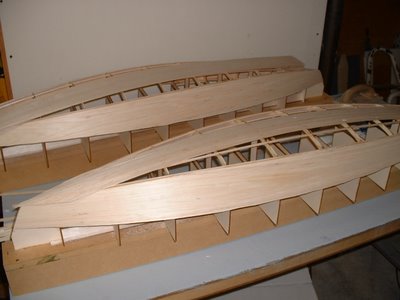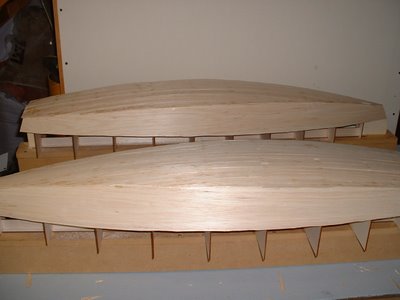
The first step was bending the forward end of the long battens into position by sawing a horizontal kerf back almost to the frame and then installing screw eyes and turnbuckles to pull them down into position. The kerf was sawn on the table saw before they were epoxied in place.
The fitting of the first bottom piece involved making some measurements to determine if I could start with a half sheet of plywood. The answer was "Yes, but not a perfect rectangle". I needed about 24 1/2" from center line of the keel to the widest part of the side. So I split the 4x8 sheet with a slight angular cut, 25" wide on one end and 23" on the other using my circular saw and 8 guide board. I positioned the sheet onto the bottom using the factory 90 degree corner straight edge along the centerline of the keel with enough length forward to make it to the tip of the stem. Three positioning screws were put in along the straight portion of the keel. Then screw blocks were started about midway down the side and put in every 3" to pull the bottom down into place. After several blocks were installed, a line could be traced underneath by bumping the panel down into position and marking the underneath side, however the most forward part could only be guessed at because the panel was too stiff to bend into position. Then it was removed, rough cut to shape, and reinstalled.

Then the forward part where it needed to be fit perfectly into a butt joint was marked for another rough cut. The marking was done by putting a heavy coat of purple crayola along the previously fit side edge and then bumping the bottom piece down into the crayola to leave a line marked on the underneath side of the bottom. The panel was removed again and trimmed with the circular saw to within about 1/16" of the crayola line. Back on the boat and the slow process of fitting the forward butt joint was done - inch by inch. My 1" rabbet plane was great for getting the fit pretty close. Files and a paint scraper were also used. As a part of the joint was fit (sitting on the panel would push it into place), another screw block was put in place to bring it home. As the fit progressed, screw blocks were also placed along the stem to bring this side of the panel along. The panel began to overlap the stem as it twisted into position and excess material was cut alway with a handsaw. Every bit of extra panel removed made the bending easier. After about 4 hours of trimming, sitting and fitting, it was in place.
Then all remaining screw hole placements were marked along the chine and keel, the panel removed and screw holes placements were marked for the battens. Countersunk screw holes were then drilled for the remaining chine and keel holes that would not be using screw blocks. Straight holes were drilled for the battens as machine screws would be used for these during glue up. This panel was then temporarily clamped in place upside down on the other side of the boat to make sure it would be a good starting point for the other side. It was. It was traced onto the other half of the plywood.

A coat of epoxy was spread on the underneath side of the panel and all mating surfaces on the framework were coated with epoxy. Then a batch of thickened epoxy was spread on the framework. The forward part of the long batten was un-turnbuckled, the kerf coated with thickened epoxy and then re-turnbuckled into submission. The panel was then placed on the boat, the locating screws put in place and all screw blocks reinstalled. After putting in a couple along the chine in the middle of the boat, I moved forward to the transition joint and ensured that it was all coming togther in the same location, secured a screw block and then filled in the rest moving forward towards the bow. Then remaining holes got silicon-brass screws along the keel and chine. Machine screws #6, 3/4" long were used to secure the battens. A 24" reversible squeeze clamp was converted to a pusher and used from underneath to push the battens up tight to the bottom prior to screwing.
The next day, screw blocks were removed, countersunk holes drilled and 7/8" silicon-brass screws installed. The butt joint looked good with the largest gap being about 1/32". Excess epoxy was cleaned up and the forward part of the panel trimmed along the keel back to centerline or in the most forward part, cut and filed flush with the stem.
Back to the other panel with the traced line from the first panel. A bevel was hand planed on the panel edge where it would butt along the certerline of the keel to the previously installed panel. The bevel would provide a tight fit. Then it was rough cut, put on the boat and the whole fitting process began again. I thought it would be faster, but the keel centerline where the stem begins to curve also had to be precisely fit, and I think I was getting tired. It took forever, just like the first one. No clamps could be used on this one, so I had to make a few more screw blocks. It all came together nicely...epoxing in place would be another day.

The next evening, my friend Rick was recruited again and he dismantled the second bottom piece from the boat while I cleaned off my working table so we could put in screw holes and epoxy away. Rick is now a fully trained professional grade epoxy applicator guy so Ive got him ready for helping with fiberglassing the hull. This second bottom piece went in place nicely and a couple of beers were consumed in celebration.
The next part was the last two pieces to finish the bottom. The first step was to make the reinforcing butt pieces for the joint. Pieces of 1/4" plywood were ripped the approximate width to fit between the battens. Each piece is about 9" long. They were then fit, epoxied, clamped and screwed with about 4 each of #8 3/4" screws. Then the bottom piece was cut, fit, epoxied, screwed and clamped. Pretty simple compared to the rest of the bottom and side pieces.













 The first step was bending the forward end of the long battens into position by sawing a horizontal kerf back almost to the frame and then installing screw eyes and turnbuckles to pull them down into position. The kerf was sawn on the table saw before they were epoxied in place.
The first step was bending the forward end of the long battens into position by sawing a horizontal kerf back almost to the frame and then installing screw eyes and turnbuckles to pull them down into position. The kerf was sawn on the table saw before they were epoxied in place.


